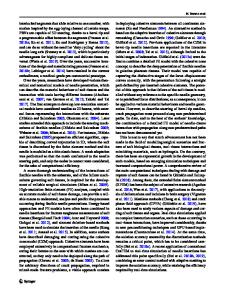Saturated-Unsaturated Transient Finite Element Seepage Model for Geotechnical Engineering
The analysis of seepage through porous media is of interest to many disciplines of engineering. In geotechnical engineering, seepage analysis is required in slope stability analysis, in groundwater contamination control and in the design of various hydrau
- PDF / 1,094,049 Bytes
- 10 Pages / 430.866 x 649.134 pts Page_size
- 85 Downloads / 385 Views
SATURATED-UNSATURATED TRANSIENT FINITE ELEMENT SEEPAGE MODEL FOR GEOTECHNICAL ENGINEERING L. Lam and D. G. Fredlund Department of Civil Engineering, College of Engineering, University of Saskatchewan, Saskatoon, Canada, S7N OWO INTRODUCTION The analysis of seepage through porous media is of interest to many disciplines of engineering. In geotechnical engineering, seepage analysis is required in slope stability analysis, in groundwater contamination control and in the design of various hydraulic structures. Geotechnical engineers have tended to focus their attention on the saturated zone in seepage analysis. Actually, unsaturated flow plays an important role in many engineering problems. For example, the movement of toxic leachates beneath tailings impoundment and sanitary landfills take place mainly under unsaturated conditions (Neuman, 1973). The transient analysis of seepage through a dam due to fluctuations in reservoir level is also highly influenced by the condition of the unsaturated zone (Freeze, 1971). Furthermore, in groundwater seepage problems involving infiltration and evaporation, realistic solutions can only be obtained if the unsaturated zone is properly taken into account. The problems of water flow in saturated-unsaturated soils lead to nonlinear partial differential equations that are difficult to solve by graphical or analytical methods. With the development of high speed digital computers, numerical methods are increasingly used in solving the governing differential equation. A two-dimensional transient finite element seepage analysis model is proposed. Two example problems are presented to demonstrate the capabilities of the model. BACKGROUND Some of the earliest theoretical work in the area of flow through unsaturated soils was presented by Richards in 1931. J. P. Laible et al. (eds.), Finite Elements in Water Resources © Springer-Verlag Berlin Heidelberg 1984
114
Richards (1931) recognized that Darcy's law, which was originally proposed for saturated soils can equally be applied to unsaturated soils. The essential difference is that the coefficient of permeability is a constant for saturated soil, while it is a function of suction or moisture content for the unsaturated soil. In 1937, Casagrande proposed a graphical method for the solution of seepage problems. The flow-net method of solution is practical when the boundary of the region under analysed is clearly defined and the soil medium is homogeneous and isotropic. However, as is often the case, when the region is nonhomogeneous and highly anisotropic, a solution by means of sketching flow nets is not practical. Furthermore, Casagrande (1937) assumed that water flowed only in the saturated zone of the porous media. As a result, the line of seepage was considered to be the uppermost flow line, and there should be no water flow across the line of seepage from the saturated zone to the unsaturated zone. In 1958, Gardner proposed a general relationship between the coefficient of permeability and the capillary pressure for unsaturated soils.
Data Loading...











